According to the 2010 census, there are over five million Tatars in Russia. Kazan Tatars have their own national autonomy within Russian Federation- Republic of Tatarstan. Siberian Tatars do not have national autonomy. Meanwhile, not all of them want to call themselves simply Tatars. In the course of the census, about 200 thousand people indicated that they were exactly "Siberian". And this position is justified.
One of the main questions: whether to count Tatars one people or is it a union of close ethnolinguistic groups? Among the Tatar sub-ethnic groups, in addition to the Kazan and Siberian Tatars, there are also Tatars-Mishars, Astrakhan, Polish-Lithuanian and others.
Quite often even the common name - "Tatars" - is not accepted by many representatives of these groups. For a long time Kazan Tatars called themselves "Kazan", Siberian - "Muslims". In Russian sources of the 16th century, Siberian Tatars were called "busormans", "Tatars", "Siberian people". The common name for the Kazan and Siberian Tatars appeared through the efforts of the Russian administration at the end of the 19th century. In Russian and Western European practice, for a long time even representatives of peoples who did not belong to them were called "Tatars".
Language
Now many Siberian Tatars have adopted the official point of view that their language is the eastern dialect of literary Tatar, which is spoken by the Volga Tatars, but there are also opponents of this. According to their version, Siberian-Tatar is an independent language belonging to the northwestern (Kypchak) group of languages; it has its own dialects, which are subdivided into dialects. For example, the Tobol-Irtysh dialect includes Tyumen, Tara, Tevriz and other dialects. Not all Siberian Tatars understand literary Tatar. However, it is on it that teaching in schools is carried out and it is on it that they study in universities. At the same time, Siberian Tatars prefer to speak their own language at home.
Origin
There are several versions of the origin of the Tatars: Bulgaro-Tatar, Turkic-Tatar and Tatar-Mongol theory. Supporters of the fact that the Volga and Siberian Tatars are two different people, adhere mainly to the Bulgaro-Tatar theory. According to her, the Kazan Tatars are the descendants of the Bulgars, the Turkic-speaking tribes who lived on the territory of the Bulgar state.
The ethnonym "Tatars" came to this territory with the Mongol-Tatars. In the XIII century, under the onslaught of the Mongol-Tatars, the Volga Bulgaria became part of the Golden Horde. After its collapse, independent khanates began to form, the largest of which was Kazan.
At the beginning of the 20th century, the historian Gainetdin Akhmetov wrote: “Although it is traditionally believed that the Bulgars and Kazan are two states that replaced one another, but with a thorough historical comparison and study, it is easy to find out their direct heredity and, to some extent, even their identity: in Kazan the Khanate lived the same Türko-Bulgar people ”.
Siberian Tatars are defined as an ethnos formed from a complex combination of Mongolian, Samoyed, Turkic, Ugric components. First, the ancestors of the Khanty and Mansi came to the territory of Siberia, after them the Turks began to penetrate, among whom were the Kipchaks. It was from among the Kypchaks that the core of the Siberian Tatars was formed. According to some researchers, some of the Kypchaks migrated further to the territory of the Volga region and also mixed with the Bulgars.
In the XIII century in Western Siberia came the Mongol-Tatars. In the XIV century, the first state formation of the Siberian Tatars arose - the Tyumen Khanate. V early XVI century it became part of the Siberian Khanate. Over the course of several centuries, there was also a mixing with the peoples who lived in Central Asia.
The formation of the Kazan and Siberian Tatars as ethnic groups took place at approximately the same time - around the 15th century.
Appearance
A significant part of the Kazan Tatars have a Caucasian appearance (up to 60%). It is sometimes noted that the appearance of the Volga Tatars was formed as a result of contacts with the Finno-Ugric peoples. There are especially many fair-haired and light-eyed people among the Kryashens - a group of baptized Tatars who also live in the territory of Tatarstan. Siberian Tatars look more Mongoloid - they are dark-eyed, dark-haired, high-cheekbones.
Customs
Siberian and Kazan Tatars are mostly Sunni Muslims. However, they also retained elements of pre-Islamic beliefs. From the Siberian Turks, for example, the Siberian Tatars inherited the veneration of ravens for a long time - now the ritual of "crow's porridge", which was cooked before the start of sowing work, is almost forgotten.
The Kazan Tatars had rituals that were largely adopted from the Finno-Ugric tribes, for example, wedding ceremonies. Ancient funeral rites, now completely supplanted by Muslim traditions, originated from the rituals of the Bulgars.
To a large extent, the customs and traditions of the Siberian and Kazan Tatars have already been mixed and unified. This happened under the influence of globalization, and even earlier, after many residents of the Kazan Khanate conquered by Ivan the Terrible migrated to Siberia.
Each nation has its own distinctive features, which make it possible to determine the nationality of a person almost without mistakes. It is worth noting that the Asian peoples are very similar to each other, since they are all descendants of the Mongoloid race. How can a Tatar be identified? What is the difference between the appearance of the Tatars?
Uniqueness
Without a doubt, each person is unique, regardless of nationality.
And yet, there are certain common features that unite representatives of a race or nationality. It is customary to refer the Tatars to the so-called Altai family... This is a Turkic group. The ancestors of the Tatars were known as farmers. Unlike other representatives of the Mongoloid race, the Tatars do not have pronounced features of appearance.The appearance of the Tatars and the changes that are now manifested in them are largely caused by assimilation with Slavic peoples... Indeed, among the Tatars, sometimes fair-haired, sometimes even red-haired representatives are found. This, for example, cannot be said about Uzbeks, Mongols or Tajiks. Do the eyes of the Tatars have any peculiarities? They do not necessarily have narrow eyes and dark skin. Are there any common features of the Tatars' appearance?
Description of the Tatars: a little history
Tatars are among the most ancient and populous ethnic groups. In the Middle Ages, the mention of them excited everyone around: in the east from the coast The Pacific and up to the Atlantic coast. A variety of scholars have included references to this people in their works. The mood of these recordings was clearly polarized: some wrote with rapture and admiration, while others showed fear. But one thing united everyone - no one remained indifferent. It is quite obvious that it was the Tatars who had a tremendous influence on the course of the development of Eurasia. They managed to create a distinctive civilization that influenced a variety of cultures.
In history Tatar people there were both ups and downs. Periods of peace gave way to violent times of bloodshed. Ancestors modern Tatars took part in the creation of several strong states at once. Despite all the vicissitudes of fate, they managed to preserve both their people and their identity.
Ethnic groups
Thanks to the works of anthropologists, it became known that the ancestors of the Tatars were not only representatives of the Mongoloid race, but also Europeans. It was this factor that led to the variety in appearance. Moreover, the Tatars themselves are usually divided into groups: Crimean, Ural, Volga-Siberian, South Kama. The Volga-Siberian Tatars, whose facial features have the greatest signs of the Mongoloid race, are distinguished by the following features: dark hair, pronounced cheekbones, brown eyes, a wide nose, a fold over the upper eyelid. Representatives of this type are few in number.
The face of the Volga Tatars is oblong, the cheekbones are not too pronounced. The eyes are large and gray (or brown). The nose is humped, oriental type. The physique is correct. In general, the men of this group are quite tall and hardy. Their skin is not dark. Such is the appearance of the Tatars from the Volga region.
Kazan Tatars: appearance and customs
The appearance of the Kazan Tatars is described as follows: a strong built strong man. From the Mongols, a wide oval of the face and a somewhat narrowed cut of the eyes are noticeable. The neck is short and strong. Men rarely wear thick beards. Such features are explained by the fusion of Tatar blood with various Finnish peoples.
The marriage ceremony is not like a religious event. From religiosity - just reading the first chapter of the Koran and a special prayer. After marriage, a young girl does not immediately move to her husband's house: for another year she will live in her family. It is curious that her newly-made husband comes to her as a guest. Tatar girls are ready to wait for their lover.
Few have two wives. And in those cases when this happens, there are reasons: for example, when the first is already old, and the second - a younger - is now running a household.
The most common Tatars of the European type - the owners of light brown hair and light eyes. The nose is narrow, aquiline or with a hump. Growth is low - women have about 165 cm.
Peculiarities
Some features were noticed in the character of a Tatar man: hard work, cleanliness and hospitality border on stubbornness, pride and indifference. Respect for elders is what distinguishes Tatars especially. It was noted that representatives of this people tend to be guided by reason, adjust to the situation, and are law-abiding. In general, the synthesis of all these qualities, especially hard work and perseverance, makes a Tatar man very purposeful. Such people are capable of achieving success in their careers. The work is carried through to the end, they have a habit of getting their way.
A purebred Tatar strives to acquire new knowledge, showing enviable perseverance and responsibility. Have Crimean Tatars there is particular indifference and calmness in stressful situations. Tatars are very curious and talkative, but during work they are stubbornly silent, apparently so as not to lose concentration.
One of characteristic features& mdash, self-esteem. It manifests itself in the fact that the Tatar considers himself special. As a result, there is a certain arrogance and even arrogance.
Cleanliness distinguishes the Tatars. In their homes, they do not tolerate disorder and dirt. Moreover, it does not depend on the financial capabilities - both rich and poor Tartars are jealous of cleanliness.
My home & mdash, your home
Tatars & mdash, people are very hospitable. We are ready to host a person, regardless of his status, faith or nationality. Even with a modest income, they show cordial hospitality, ready to share a modest dinner with a guest.
Tatar women stand out for their enormous curiosity. They are attracted by beautiful clothes, they observe people of other nationalities with interest, follow fashion. Tatars are very attached to their home, they devote themselves to raising children.
Tatar women
What an amazing creation - Tatar woman! In her heart lies an immeasurable, deepest love for her loved ones, for children. Its purpose is to bring peace to people, to serve as an example of peacefulness and morality. The Tatar woman is distinguished by a sense of harmony and special musicality. She radiates a certain spirituality and nobility of the soul. The inner world of a Tatar woman is full of riches!
Tatar girls from a young age are aimed at a strong, durable marriage. After all, they want to love their husband and raise future children behind solid walls of reliability and trust. No wonder it says Tatar proverb: `` A woman without a husband is like a horse without a bridle! '' The word of a husband for her is a law. Although witty Tatar women complement & mdash, there is, however, an amendment to any law! And yet they are devoted women who sacredly honor traditions and customs. However, do not expect to see a Tatar woman in a black burqa - this is a stylish lady who has a sense of her own dignity.
The appearance of the Tatars is very well-groomed. Fashionistas have stylized clothes in their wardrobe that emphasize her nationality. For example, there are shoes that imitate chitchek - national leather boots worn by Tatar girls. Another example of & mdash, applications where patterns convey the stunning beauty of the earth's flora.
And what about the table?
Tatar woman & mdash, wonderful hostess, loving, hospitable. By the way, a little about the kitchen. National cuisine Tatars are quite predictable in that the basis of the main dishes is often dough and fat. Even a lot of dough, a lot of fat! Of course, this is far from the healthiest food, although guests are usually offered exotic dishes: kazylyk (or dried horse meat), gubadiya (is a puff cake with a wide variety of fillings, from cottage cheese to meat), talkysh-kaleva (incredibly high-calorie dessert from flour, butter and honey). You can drink all this rich treat with ayran (a mixture of katyk and water) or traditional tea.
Like male Tatars, women are distinguished by determination and perseverance in achieving goals. Overcoming difficulties, they show ingenuity and resourcefulness. All this is complemented by great humility, generosity and kindness. Truly, a Tatar woman - this is a wonderful gift from above!
Several centuries have passed since the events of the "Mongol-Tatar yoke", but the passion for the study of this issue does not subside. And until the whole truth comes out, until the last masks from the "Mongol-Tatars" are removed, the researchers will continue to delve into this very interesting topic.
Unfortunately, the scribes of history have done a lot so that the true events that took place during the "Mongol-Tatars", and in other times, were forgotten and erased from our memory. Destruction of authentic evidence, their falsification, suppression of the remaining traces - these are the few tools that are used by the enemies of humanity in order to control society and enslave the consciousness of an individual. But it is not always possible to hide and destroy all artifacts. So it is with the topic of "Mongol-Tatars": so much data has accumulated that contradict the official version of history, that very few people still have doubts that "Mongol-Tatars", like the "yoke", never existed. And also the fact that the "Mongolo-Tatars" are not at all Mongoloids, as they imposed on the whole world, but the Europeans!
Where did the term "Mongol-Tatars" come from?
In 1817 Christian Kruse published an Atlas of European history("Atlas and tables for reviewing the history of all European lands and states from their first population to our times"), where he first introduced the term "Mongol-Tatar yoke" into scientific circulation (this work was translated into Russian in 1845).
In Russia, the term "Mongol-Tatars" was introduced into circulation by the famous historian P. N. Naumov in 1823. And only from that time, from the 19th century, it appeared in textbooks and scientific articles. In all the surviving sources, be it maps, chronicles, dictionaries, of course, there are no "Mongol-Tatars". Studying the etymology of the word "Mongolo-Tatars", we see that this term was artificially invented and introduced into use much later than the events of the "Mongol-Tatar yoke". And now for more details.
Looking at the maps and illustrations of the atlases that have come down to us, we will come across the words MOGOL, MOGUL! Please note, without the letter "N".
The word "Mogul" is of Greek origin and means "Great" in translation. That is how the Great Ones called us, Slavs, Rus, some Europeans, Arabs, Chinese, Japanese on their maps, on engravings and other surviving artifacts. And those whom historians call Mongols call themselves Khalkhi or Khalkhu, Oirats, etc. But not by the Mongols. Yes, and historians began to call them Mongols only in the XX century.
And now about the word "Tatars".
Ie not Tatars, but Tartars. Yes, exactly the TARTARS. And this people lived on the territory of Great Tartary, that's why they called them that!
Here is what Nikolai Levashov writes:
“… The name of Tartary has nothing to do with the name of the Turkic tribes. When foreigners asked the inhabitants of this country about who they were, the answer was: "We are the children of Tarkh and Tara" - brother and sister who, according to the ancient Slavs, were the guardians of the Russian land (Goddess Tara is the patroness of Nature and her older brother Tarkh - May God be the keeper of the ancient Great Wisdom) ”. The word Tartary comes from the confluence of the words Tarkh and Tara. And the fact that later the letter "R" from the words of Tartar and Tartar was thrown out of the spelling and pronunciation of the word, suggests that someone needed it. In order to erase from the consciousness of the people themselves the memory of the country, which was truly called the Great Tartary, and of the people themselves - the Tartars. And for several centuries the scribes of history have almost succeeded. Almost.
So it turns out that in one case the Slavs were called Mughals, in the other Tartars. But never - "Mongol-Tatars"! And the words "Mongols" and "Tatars" are already a modern translation of would-be historians from science. And if you take the original of the surviving artifact and the translation, you can see for yourself how "Tartars" turn into "Tatars", and "Mughals" into "Mongols".
What did the "Mongol-Tatars" known to all of us look like?
According to the official version of history, "Mongol-Tatars" are representatives of the Mongoloid race, who have a different eye structure than other races, and above all these are slanted eyes with a highly developed fold of the upper eyelid, black hair, dark eyes, with a yellowish skin color, with strongly protruding cheekbones, flattened face and poorly developed hairline.
And, of course, in all films "Mongol-Tatars" appear exactly as described above. In history lessons, teachers repeat the same thing, teachers in universities hammer into the heads of students the information that "Mongol-Tatars" are Mongoloids, and nothing else. With rare exceptions, teachers who are not afraid to go across the educational system.
In general, there are no affirmative sources that would unequivocally say that the "Mongolo-Tatars" were Mongoloids. Rather, on the contrary, there are a very large number of artifacts that testify to the opposite. Or rather, they say that all the famous personalities of the times of the "Mongol-Tatars" were Europeans! And not just Europeans, but representatives of the white race - it would be more correct. But this information is carefully hushed up, because we will have to rewrite the whole history that was imposed on us in the 18th century.
Let's take a closer look at some of them.
Genghis Khan.
To begin with, history knows many Genghis Khans. But we will consider the one who became famous all over the world. The one who is called the founder and first khan of the Mo (n) Gol empire.
In fact, Chinggis Khan, as many people think, is not a name, but a title. And khans were called military princes in Russia. What is the real name of the well-known Genghis Khan? The real name is Timur. Or, as was customary in those ancient times - Timur Chin (or Temujin, or Temuchin in a distorted pronunciation, as Genghis Khan was often called). The name of Genghis Khan was sorted out. Now let's see what kind of "Mongol-Tatar" he was.
Of all the surviving portraits of Genghis Khan, historians declared only one authentic. And this portrait of Emperor Taizu (Genghis Khan) is kept in national museum Taipei Palace, Taiwan:
The Mongolian doctor of sciences D. Bayar reports the following about the only portrait of Genghis Khan: “The image of Genghis Khan was preserved in the walls of the palaces of the rulers of the Yuan times. When the rule of the Manchus was overthrown in 1912, the historical and cultural heritage was transferred to the list of the Middle State. The set of these historical treasures included more than 500 paintings depicting rulers and their wives, sages and thinkers. There were also portraits of eight Mongol khans, seven khansh. These portraits were published in Beijing in 1924, 1925 and 1926. In this series of Mongol rulers, Genghis Khan is depicted wearing a light-colored Mongolian fur hat, with a slanting border, a wide forehead, a face emitting light, a gaze, bearded, braided behind the ears, and of a very old age. At the expense of the reliability of this image of Genghis Khan, a detailed study was carried out and it turned out that this portrait on a fabric woven with a length of 59 cm and a width of 47 cm was starched and edged in 1748 ”. Those. this portrait dates back to the 18th century !!! But it was in this century that there was a global process of falsification of history all over the world, including in Russia and in China. So this portrait is another invention and falsification of historians.
Among the reproductions about Genghis Khan, another "medieval" Chinese drawing is widespread, which was made even later than the "official" portrait:
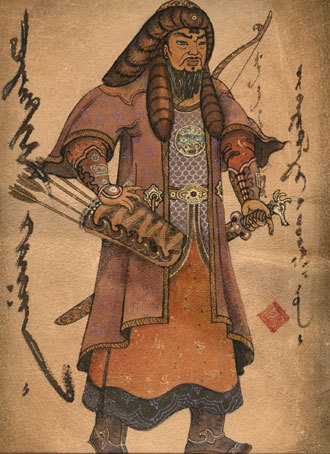
The drawing is made with ink on silk and depicts Genghis Khan in full growth in a Mongolian hat with a Mongolian bow in his right hand, a quiver with arrows behind his back, his left hand grasps the hilt of a saber in a sheath.
Rashid ad Din, a famous Persian figure, in his "Collection of Chronicles" also cites several miniatures, where Chinggis Khan appears in his imagination as a Mongoloid.
So what did the real Genghis Khan look like? And are there other sources indicating that he was not a Mongoloid ?!
The historian Gumilyov in his book "Ancient Russia and the Great Steppe" describes it as follows: "The ancient Mongols were, according to the testimony of chroniclers and the finds of frescoes in Manchuria, a tall people, bearded, fair-haired and blue-eyed ... Temujin is tall and majestic in stature, with a broad forehead and long beard. The personality is militant and strong. This makes him different from others "
The Borjigins have eyes "blue-green ..." or "dark blue, where the pupil is surrounded by a brown rim" "Histoire de Mogols el des Tatares par Aboul Ghazi Bahadour Khan, publiee, traduite el annotee par Baron Demaison. SPb., 1874. T. 11. P. 72, Cahun L. Introduclion a l "histoire de l" Asie. Paris, 1896. P. 201 "".
The Borjigins are a Mongolian family to which Timur-Genghis Khan belonged. Borjigin is translated as "blue-eyed".
By the way, Rashid ad Din in his "Collection of Chronicles" also writes that Genghis Khan belonged to the Borjigin family, and had bright eyes. And here you can trace a discrepancy between the text, where Genghis Khan appears tall and light-eyed, and illustrations, in which the Great General is clearly Mongoloid, short in stature and dark eyes and hair color. But this is a topic for another conversation.
Also preserved is a Chinese drawing of the 13th-14th centuries, which depicts Genghis Khan during a falconry:
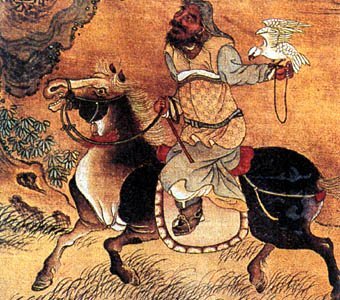
As you can see, in this picture, Genghis Khan is not a Mongoloid at all! And a typical Slav, with a thick beard and signs of a clearly white race.
Yes, and Marco Polo sees Genghis Khan as a European, and in his miniatures draws him as one hundred percent Slav. In the miniature "The Wedding of Genghis Khan to the Kingdom":
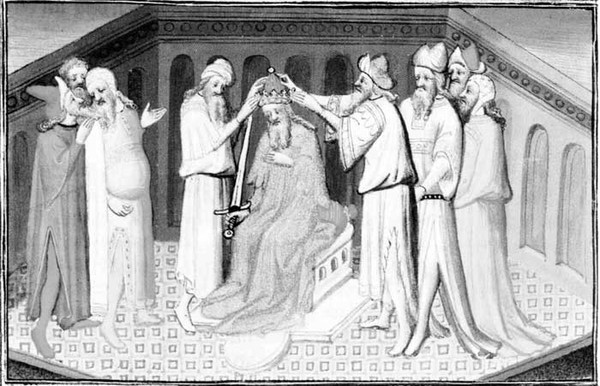
Marco Polo dresses both Genghis Khan and his retinue in European clothes, crowning the Great General with a three-leafed crown, which has always been an attribute of European rulers. And the sword that Genghis Khan holds in his hands has a shape that was peculiar to Russian swords!
So it turns out that Chinggis Khan was a blonde guy with blue eyes !!! So much for the Mongols!
So, in addition to the "official" evidence recognized by science, there are others according to which Timur-Chinggis Khan looks more like a Slav than a Mongoloid, who are not very tall, have obviously black hair and dark eyes. Nevertheless, it is not customary to talk about it.
But before drawing any conclusions, let's see how other Great commanders and leaders of the Mo (n) Gol era looked like, whose names have come down to us through the centuries.
Khan Batu.
Batu Khan, or rather Batu Khan, was the grandson of Timur-Chinggis Khan. This fact is recognized by modern historians, and it is written about it in chronicles and other documents.
Well, as usual, historians see him as a Mongoloid. Waters his portrait, which they recognize as authentic:
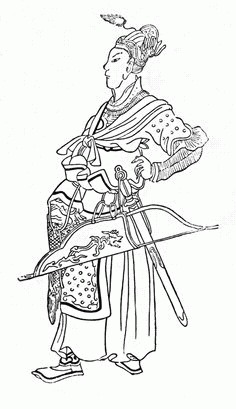
This is a Chinese manuscript "The History of the First Four Khans from the Genghis Clan."
But let's think logically. Batu also belongs to the Borzhigin family and should at least with the edge of his ear resemble his grandfather, i.e. Genghis Khan, and have either blonde hair or blue eyes, or be at least 170 cm tall, or has other signs of a white race.
A bust of Batu Khan, located in Turkey, has survived to this day:
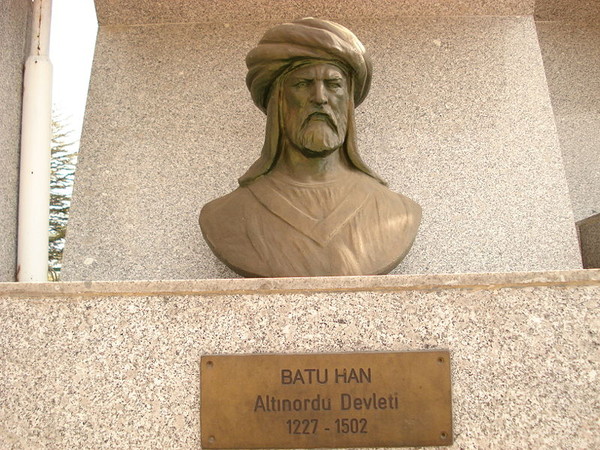
Of course, looking at the bust, it is difficult to draw conclusions about the color of his eyes and hair. But something else is visible. Before our eyes appears a typical European with a thick beard, in whose features not the slightest sign of a Mongoloid is observed at all!
And here is another source - “The capture of Suzdal by Batu in 1238. Miniature from the "Life of Euphrosyne of Suzdal" of the 16th century. List of the XVIII century ":
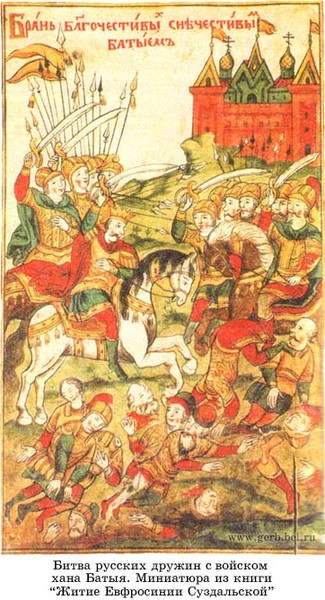
This miniature depicts Khan Batu in a crown, on a white horse, who, accompanied by his squad, enters the city. His face is purely European, in no way Turkic. Yes, and some kind of Slavic army, isn't it ?!
In another chronicle illustration, Batu Khan appears in the image of the Russian tsar with his Russian warriors:

So the grandson of Genghis Khan, Khan Batu, did not go far from his grandfather in appearance.
Khubilai.
Kublai or Kubla Khan, like Batu Khan, was the grandson of Genghis Khan, and, like his grandfather, became famous in earnest. Consider this mo (n) goal.
According to the official version of history, Khubilai conquered almost the whole world, conquering China and practically conquered Japan (and if it were not for the tornado, he would have succeeded). Of course, the men of the official history see him as a Mongoloid:
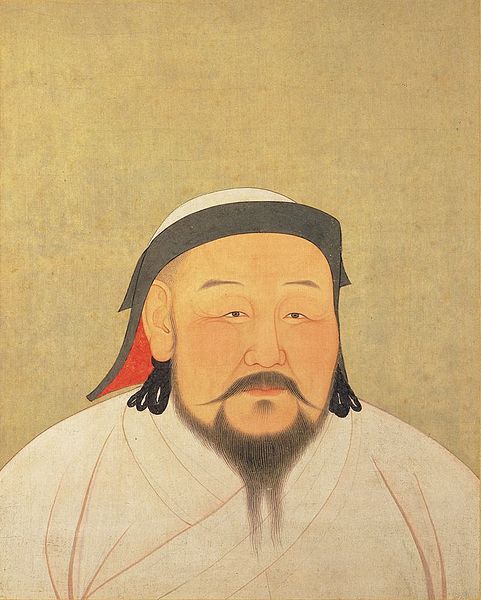
For me, Marco Polo portrays Kublai as a European. In The Book of the Diversity of the World, there is an illustration depicting the arrival of Marco Polo at Kublai's headquarters:

Here Kublai is again not my goal, but a European !!! Facial features, beard - everything indicates that we are faced with a man of European appearance.
And the 4 wives of Khubilai:
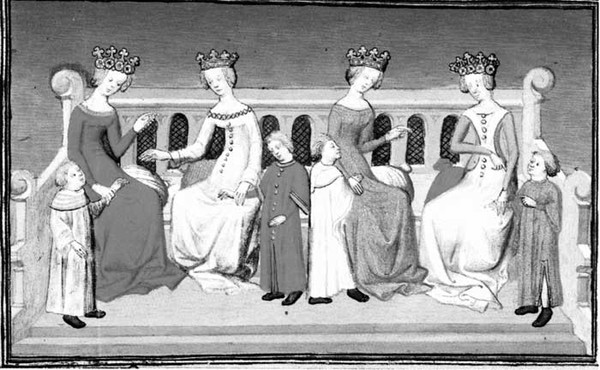
As you can see, they are not representatives of the Mongoloid race at all, and look like typical ladies of medieval Europe. And in crowns with trefoils, and the trefoil is a fighting symbol of the Slavic-Aryans !!!
And here is another illustration of The Book of the Diversity of the World:
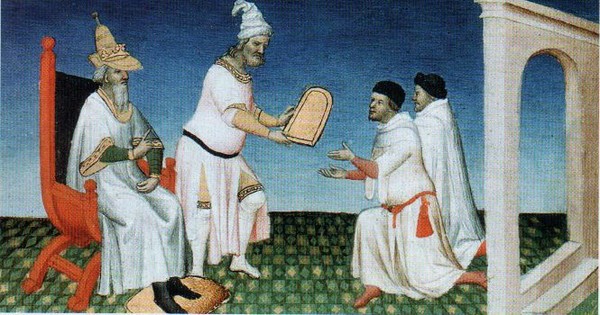
On it, Khubilai presents the Polo brothers with the "golden lady" and sends them as ambassadors to the Pope. Again, the appearance, clothing, attributes - everything is European!
I would also like to draw your attention to the "golden lady". This is the so-called golden paiza. Paiza is a credential tag issued as a symbol of the delegation of power, the endowment of special powers. Surprising as it may seem, all the paizi belonging to the Mo (n) Gol khans were found on the territory of Russia. Not a single paizi was found in the areas of modern Mongolia! This is another confirmation of the tale of the "Mongol-Tatar" yoke.
But back to Khubilai.
A 13th century Japanese scroll depicts Kublai's campaign in Japan:

On the right of the scroll is a wounded Japanese warrior, on the left is a medieval mo (n) goal. In the painting, Khubilai's Mo (n) Golsky army is traditionally dressed in Russian clothes and boots. Noteworthy is the foot formation characteristic of the tactics of the ancient Russians, as well as the traditional Russian weapons: straight swords and compound bows. And pay attention also to the fiery-colored crest-oseledets sticking out from the crown of each of the three warriors-mo (n) heads - a detail of the external appearance inherent exclusively to the Slavs. But the most convincing are those who leave no doubt about their ethnicity.
One of Khubilai's ships can be seen on the miniature from the "Scroll of the Mongol Invasion":
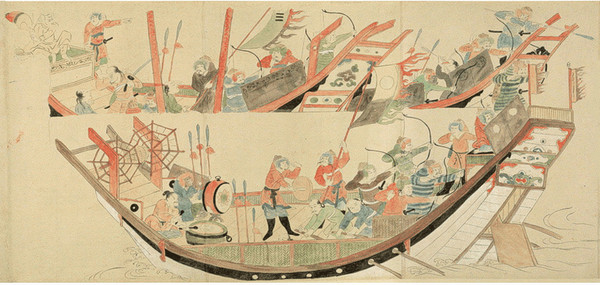
The ship of the mo (n) Golskaya flotilla is predominantly with Russian warriors! The same as in the previous picture.
Those whom the Japanese call medieval mo (n) goals are one hundred percent Slavs!
The same story can be traced here as with Genghis Khan. Tamerlane is not a name, but rather a nickname. And his name is Timur.
According to the description of Ibn Arabshah, Timur was tall, broad-shouldered, had a large head and bushy eyebrows, had long legs and long dry arms, and wore a large beard. Timur was lame on his right leg. His eyes were like candles, but without sparkle. He had a loud voice, was distinguished by powerful strength and great courage, he was not afraid of death, he retained a clear memory until the end of his life, did not like jokes and lies, on the contrary, he liked the truth, even putting him in a difficult situation.
TN Granovsky in his "Complete Works" writes that Timur was born with white, like an old man's hair and along the female line he belonged to the offspring of Genghis Khan (who, as the sources tell us, were fair-haired and blue-eyed). Although other historians claim that Timur did not belong to the Genghisid family. But we have a different task, the main thing for us is whether he was naked and what he looked like.
In the town of Shogut, along with the bust of Batu Khan, there is also a bust of Timur:
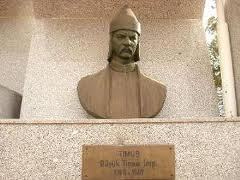
As you can see, Timur-Tamerlane here is a European, a typical Cossack. And in the minds of Italians, Dutch, French, Timur-Tamerlane is also a representative of the white race, not Mongoloid:
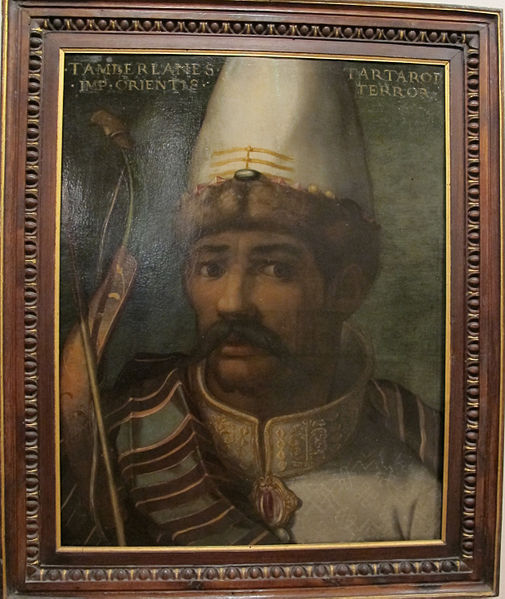
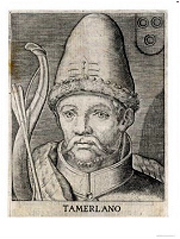
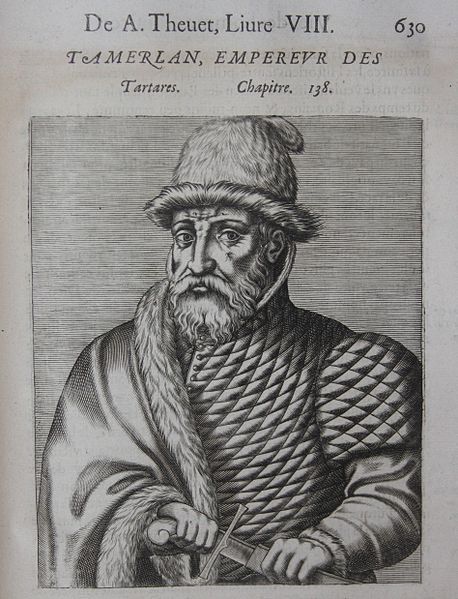

On Iranian miniatures of the 15th-16th centuries, Timur is depicted with a thick white beard and outward signs white race:
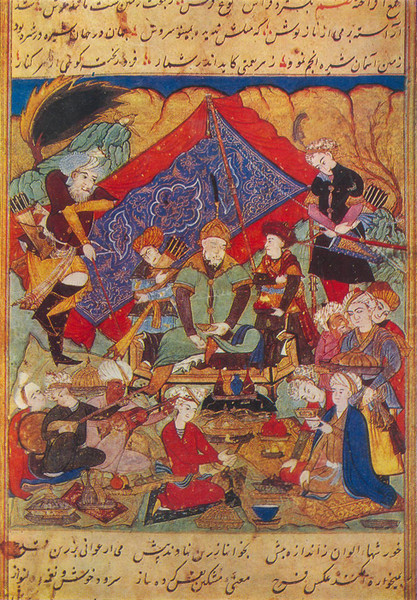
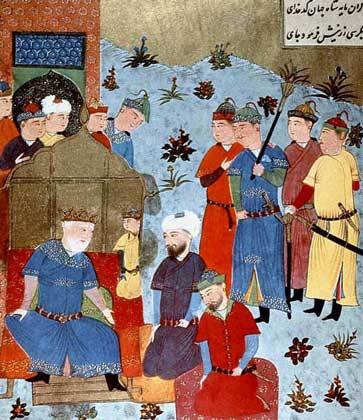
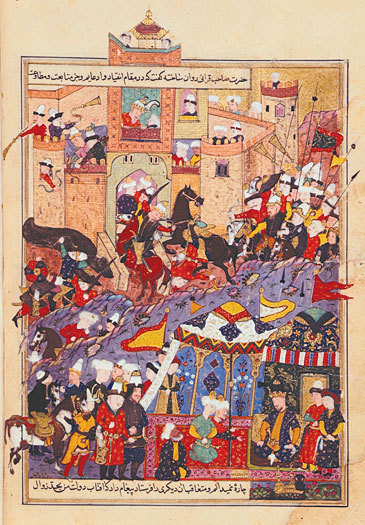
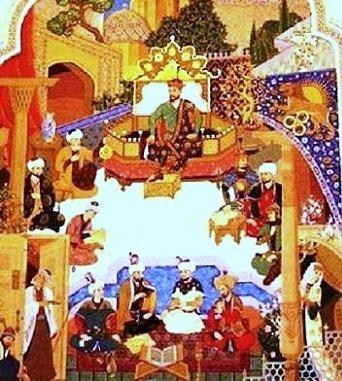
Another Iranian miniature of the 15th century by an unknown author:
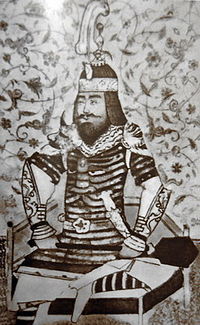
Here Timur looks European.
But, surprisingly, some contemporary artists of Timur-Tamerlane in their works reproduce his appearance not as a Mongol, but as a European! Despite the fact that in the films he appears as one hundred percent Asian. So, on the vintage block, Tamerlane is a completely Russian person, only with a black beard (apparently, so that the censorship would let it go to print):

As for the appearance and appearance of Timur-Tamerlane, then there are no problems at all. Everything fell into place after in May-June 1941 excavations were carried out in the Gur-Emir mausoleum, the burial vault of the Timurid dynasty. The expedition uncovered five graves: Timur-Tamerlane, his sons Shahrukh and Miranshah, his grandsons Ulugbek and Muhammad-Sultan.
MM. Gerasimov, a well-known anthropologist and sculpture, the author of the method for restoring the external appearance of a person on the basis of skeletal remains, was entrusted with such an important task as the appearance of the real Tamerlane to the whole world. He restores his sculptural portrait and is surprised to see that he has turned out to be a man of the European type. This is a natural European! Convex, not flat face:
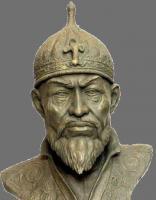
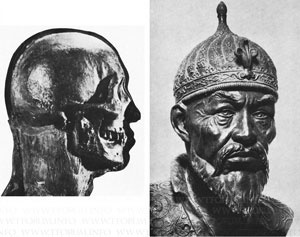
Also Gerasimov in his book "Fundamentals of face reconstruction from the skull" reports the following: "The discovered skeleton belongs to a strong man, relatively tall for a Mongolian (about 170 cm)."
And the cut of Tamerlane's eyes turns out to be not at all Mongoloid: "However, the significant protrusion of the root of the nose and the relief of the upper part of the brow indicate that the Mongolian fold of the eyelid itself is relatively weak." Further: "Contrary to the accepted custom of shaving his head, by the time of his death, Timur had relatively long hair." If Timur is a Mongol, then the hair should be black. And what do we see in reality? And here Gerasimov cannot hide the truth: Timur had the hair of a European. Indeed: “Timur's hair is thick, straight, gray-red in color, with a predominance of dark brown or red. The hair of the eyebrows is worse preserved, but nevertheless, it is not difficult to imagine and reproduce from these remnants general form brows. Individual hairs are well preserved ... Their color is dark brown ... It turns out that Timur wore a long mustache, and not trimmed over the lip, as was customary by the faithful followers of Sharia ... Timur's small thick beard had a wedge-shaped shape. Her hair is coarse, almost straight, thick, of a bright brown (red) color, with significant gray ... Even a preliminary examination of the hair of the beard under a binocular is convincing that this reddish-reddish color is her natural, and not dyed with henna, as historians described " ...
This fact alone completely destroys all previous traditionally historical attempts to evade the obvious. Here are your conclusions: Tamerlane, like his predecessors - the "Mongol-Tatars" considered above, turned out to be a fair-haired Caucasian type !!!
ULUGBEK.

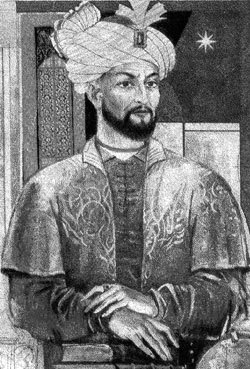
![]()
Ulugbek is the great Uzbek astronomer and patron of sciences, the grandson of Tamerlane, the ruler of Maverannahr, and after the death of his father Shahrukh was the ruler of the entire empire of Tamerlane.
Unlike his great ancestors, commanders, Ulugbek chose a different path of life, which glorified him no less than his grandfather, the Great Tamerlane. He was the Great Astronomer!
Near Samarkand, Ulugbek built an astronomical observatory, unique for those times. The result of its activity was the "New Guragan tables". In them, with an unprecedented accuracy for that time, annual movements planets (accurate to a few seconds of arc), and the Sun (inclination of the ecliptic to the equator, constant precession). There was also a catalog of 1018 stars, geographical coordinates 683 cities in Europe and Asia. Ulugbek built higher schools- madrassahs and taught them a course in astronomy. His labor was used in the East and in the West until the 18th - 20th centuries.
Ulugbek's scientific activity was contrary to the ideas and plans of Islamic clergy. He was declared a heretic, and later his murder was rigged by cutting off his head.
Ulugbek, like his grandfather, Tamerlane, was of European appearance.
Here is what Gerasimov writes about the restoration of Ulugbek's skull: “Ulugbek's skull is well preserved and, apart from the loss of almost all teeth (during his lifetime) and the cut off corners of the lower jaw (at the time of the murder), it should be considered as complete ... horizontal projection) the skull is close to the ovoid shape. Its cross section is rounded, vaulted, the occiput does not protrude. Poorly developed glabella is somewhat enhanced by small swelling of short brows, face ovoid, orbits round, high; with a barely overhanging top edge, which is not thick, but roundly blunt. The long nasal bones are very narrow at the top and in the middle part, they form a wide mouth below, the edges of the pear-shaped opening are thin, sharp, and its shape is shortened, heart-shaped. Strongly developed nasal spine slightly inclined downward. The lower edge of the orbits protrudes strongly forward, which, along with the significant flattening of the zygomatic bones, gives the skull a significant Mongoloid appearance, although at its core the skull undoubtedly has more elements of the Caucasian Pamir-Fergana round-headed type inherited from its father, Shakhrukh. There are, however, small features in the details of the structure of the skull, undoubtedly, reminiscent of his great grandfather Timur ":

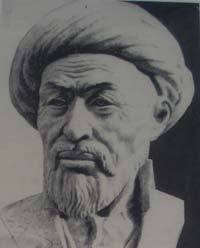
In other words, although Ulugbek's appearance has some significant signs of Mongoloidism, it nevertheless belongs to the Caucasian type.
Thus, we figured out that there were no "Mongol-Tatars" in principle, and those who were called "Mughals" and "Tartars" were people of the white race, Europeans. And famous "Mongol-Tatar" personalities, such as Genghis Khan, Batu, Khubilai, Tamerlane, Ulugbek, were Europeans. It is a fact! A fact that will have to be recognized not only by Russian historians, but also by the whole world.




